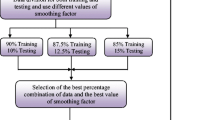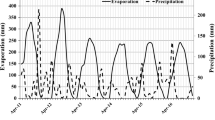Abstract
This paper presents two Artificial Neural Network (ANN) based models for the prediction of peak outflow from breached embankment dams using two effective parameters including height and volume of water behind the dam at the time of failure. Estimation of optimal weights and biases in the training phase of the ANN is analysed by two different algorithms including Levenberg—Marquardt (LM) as a standard technique used to solve nonlinear least squares problems and Imperialist Competitive Algorithm (ICA) as a new evolutionary algorithm in the evolutionary computation field. Comparison of the obtained results with those of the conventional approach based on regression analysis shows a better performance of the ANN model trained with ICA. Investigation on the uncertainty band of the models indicated that LM predictions have the least uncertainty band whilst ICA’s have the lowest mean prediction error. More analysis on the models’ uncertainty is conducted by a Monte Carlo simulation in which 1000 randomly generated sets of input data are sampled from the database of historical dam failures. The result of 1000 ANN models which have been analysed with three statistical measures including p-factor, d-factor, and DDR confirms that LM predictions have more limited uncertainty band.
Similar content being viewed by others
References
Abbaspour, K.C., Yang, J., Maximov, I., et al., Modeling hydrology and water quality in the prealpine/alpine Thur watershed using SWAT, J. Hydrol., 2007, vol. 333, pp. 413–430.
Atashpaz-Gargari, E. and Lucas, C., Imperialist competitive algorithm: An algorithm for optimization inspired by imperialistic competition, IEEE Congress on Evolutionary Computation, 2007, pp. 4661–4667.
Atashpaz-Gargari, E., Hashemzadeh, F., Rajabioun, R., and Lucas, C., Colonial competitive algorithm: a novel approach for PID controller design in MIMO distillation column process. Int. J. Intelligent Comput. Cybernetics, 2008, vol. 1, no. 3, pp. 337–355.
Babaeyan Amini, A., Nourani, V., and Hakimzadeh, H., Application of artificial intelligence tools to estimate peak outflow from earth dam breach, Int. J. Earth Sci. Eng., 2011, vol. 4, no. 6, pp. 243–246.
Coleman, S., Andrews, D., and Webby, M.G., Overtopping breaching of noncohesive homogeneous embankments, J. Hydraul. Eng., 2002, vol. 128, no. 9, pp. 829–838.
Coulibaly, P., Anctil, F., and Bobe’e, B., Daily reservoir inflow forecasting using artificial neural networks with stopped training approach, J. Hydrol., 2000, vol. 230, nos. 3–4, pp. 244–257.
Cybenko, G., Approximation by superposition of a sigmoidal function, Math. Cont. Sig. Syst., 1989, vol. 2, no. 4, pp. 303–314.
Fread, D.L., Some Limitations of Dam-Break Flood Routing Models, Preprint, American Society of Civil Engineers, Fall Convention, St. Louis, Mo, 1981.
Froehlich, D.C., Peak outflow from breached embankment dam, J. Wat. Res. Plann. Manage., 1995, vol. 121, no. 1, pp. 90–97.
Froehlich, D., Embankment Dam Breach Parameters and Their Uncertainties, J. Hydraul. Eng., 2008, vol. 134, no. 12, pp. 1708–1721.
Gupta, S. and Singh, V., Discussion of “Enhanced Predictions for Peak Outflow from Breached Embankment Dams”, Thornton, Ch.I., Pierce, M.W., and Abt, S.R., Eds., J. Hydrol. Eng., 2012, vol. 17, no. 3, pp. 463–466.
Hooshyaripor, F. and Tahershamsi, A., Comparing the Performance of Neural Networks for Predicting Peak Outflow from Breached Embankments when Back Propagation Algorithms meet Evolutionary Algorithms, Int. J. Hydraul. Eng., 2012, vol. 1, no. 6, pp. 55–67.
Hooshyaripor, F., Tahershamsi, A., and Golian, S., Application of copula method and nueral networks for predicting peak outflow from breached embankments, J. Hydro-Environ. Res., 2014, vol. 8, no. 3, pp. 292–303.
Hosseini Nasab, E., Khezri, M., Khodamoradi, S.M., and Atashpaz Gargari, E., An application of Imperialist Competitive Algorithm to Simulation of Energy Demand Based on Economic Indicators: Evidence from Iran, Europ. J. Sci. Res., 2010, vol. 43, no. 4, pp. 495–506.
Kaveh, A. and Talatahari, S., Optimum design of skeletal structures using imperialist Competitive Algorithm, Comput. Structures, 2010, vol. 88, no. 21–22, pp. 1220–1229.
Levenberg, K., A method for the solution of certain non-linear problems in least squares, Quart. Appl. Math., 1944, vol. 2, no. 2, pp. 164–168.
Marce, R., Comerma, M., Garcia, J.C., and Armengol, J., A neuro-fuzzy modeling tool to estimate fluvial nutrient loads in watersheds under time-varying human impact, Limnol. Oceanogr., 2004, vol. 2, no. 1, pp. 342–355.
Marquardt, D.W., An algorithm for least-squares estimation of nonlinear parameters, J. Soc. Ind. Appl. Math., 1963, vol. 11, no. 2, pp. 431–441.
Nazari-Shirkouhi, S., Eivazy, H., Ghodsi, R., Rezaie, K., and Atashpaz-Gargari, E., Solving the integrated product mix–outsourcing problem by a novel meta–heuristic algorithm: imperialist competitive algorithm, Expert Systems Appl., 2010, vol. 37, no. 12, pp. 7615–7626.
Noori, R., Khakpour, A., Omidvar, B., and Farokhnia, A., Comparison of ANN and principal component analysis-multivariate linear regression models for predicting the river flow based on developed discrepancy ratio statistic, Expert Systems Appl., 2010, vol. 37, pp. 5856–5862.
Noori, R., Karbassi, A.R., Mehdizadeh, H., and Sabahi, M.S., A framework development for predicting the longitudinal dispersion coefficient in natural streams using artificial neural network, Environ. Prog. Sustain. En., 2011, vol. 30, no. 3, pp. 439–449.
Noori, R. and Hooshyaripor, F., Effective prediction of scour downstream of ski-jump buckets using artificial neural networks, Wat. Res., 2014, vol. 41, no. 1, pp. 8–18.
Nourani, V., Hakimzadeh, H., and Babaeyan Amini, A., Implementation of artificial neural network technique in the simulation of dam breach hydrograph, J. Hydroinformatics, 2012, vol. 14, no. 2, pp. 478–496.
Pierce, M.W., Thornton, C.I., and Abt, S.R., Predicting peak outflow from breached embankment dams, J. Hydrol. Eng., 2010, vol. 15, no. 5, pp. 338–349.
Singh, V.P. and Scarlatos, P.D., Analysis of gradual earth dam failure, J. Hydraul. Eng., 1988, vol. 114, no. 1, pp. 21–42.
Taher-Shamsi, A., Shetty, A.V., and Ponce, V.M., Embankment Dam Breaching: Geometry and Peak Outflow Charactristic, Dam Eng., 2003, vol. 14, no. 2, pp. 73–87.
Tahershamsi, A. and Sheikholeslami, R., Optimization to identify Muskingum Model parameters using imperialist competitive algorithm, Int. J. Optim. Civil Eng., 2011, vol. 1, no. 3, pp. 473–482.
Tingsanchali, T. and Chinnarasri, C., Numerical modelling of dam failure due to flow overtopping, Hydrol. Sci. J., 2001, vol. 46, no. 1, pp. 113–130.
Wahl, T.L., Prediction of Embankment Dam Breach Parameters, A Literature Review and Needs Assessment, Bureau of Reclamation, U.S. Department of the Interior, Denver, 60, Rep. no. DSO–98–004, 1998.
Wahl, T.L., Uncertainty of predictions of embankment dam breach parameters, J. Hydraul. Eng., 2004, vol. 130, no. 5, pp. 389–397.
Willemsen, P.G., Bailer, C.A.L., and Kaempf, T.A., ICAP-Variability-Alerts Joint Working Group Meeting, Paris, October 8, 2004.
Xu, Y. and Zhang, L.M., Breaching parameters for earth and rockfill dams, J. Geotech. Geoenviron. Eng., 2009, vol. 135, no. 12, pp. 1957–1970.
Author information
Authors and Affiliations
Corresponding author
Additional information
The article is published in the original.
Rights and permissions
About this article
Cite this article
Hooshyaripor, F., Tahershamsi, A. & Behzadian, K. Estimation of peak outflow in dam failure using neural network approach under uncertainty analysis. Water Resour 42, 721–734 (2015). https://doi.org/10.1134/S0097807815050085
Received:
Published:
Issue Date:
DOI: https://doi.org/10.1134/S0097807815050085




